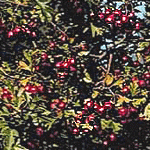|
|
The Eclectic Physician
Medicinal Herb Monographs
Hawthorn
Botanical Name
Crataegus spp
|

Crataegus oxyacantha
(Hawthorn)
|
The information on this page compiled by
Beth Burch N.D.
Index
(click on the keywords)
Introduction
Hawthorn has been traditionally used as cardiac tonics in organic and functional
heart disease. Weiss states it is particularly valuable in atherosclerotic
heart disease and angina pectoris. Modern research studies have confirmed
its value in treating heart conditions, especially early congestive heart
failure and mild hypertension.
[ Back to the Index. ]
Description
-
Hawthorn is a member of the rose family- a spiny tree or shrub native to
Europe but widely naturalized throughout the US. It has a white flower
in the spring with a interesting aroma. In the fall the fruits ripen into
red berries, which may stay on the tree long after the leaves have dropped.
The flower buds with the leaves are medicinal in Europe, but the berries
have also been traditionally used.
[ Back to the Index. ]
Constituents
-
Flavonoids
-
Oligomeric procyanidins (OPCs)
[ Back to the Index. ]
Action/Effects
-
Collagen stabilization- due to the flavonoids and proanthocyanidins, probably
important to prevent and treat atherosclerosis
-
Anti-oxidant- due to the OPCs, flavonoids (1)
-
Antiinflammatory - due to antioxidant activity of flavonoids and OPCs
-
Dilation of coronary blood vessels
-
Improvement of heart metabolism resulting in increased contractile force
-
Mildly Antihypertensive
[ Back to the Index. ]
Conditions used
for
-
Stage I and II cardiac insufficiency (congestive heart failure) (2,3)
-
Mild arrhythmias (4)
-
Mild hypertension (5)
-
Berries are also useful as supplements in health conditions that affect
collagen, such as arthritis, periodontal disease, atherosclerosis and inflammation
[ Back to the Index. ]
Dosage
-
Dried extract assayed for flavonoids- 2-7 mg total flavonoids twice a day
-
Dried extract assayed for OPC’s- 15-60 mg total OPC’s twice a day
-
Dried or Freeze-dried berries- 850-1700 mg three times a day
-
Dried or Freeze-dried flower/leaf- 600-1200 mg three times a day
-
Alcohol extract (1:5 dry) 4-6 ml three times a day
-
Slow-acting- May take up to two weeks for adequate tissue concentrations,
use for at least 4- 8 weeks to get maximum benefit
[ Back to the Index. ]
Side Effects
[ Back to the Index. ]
Contraindications
[ Back to the Index. ]
Interactions
with medications
-
May cause increased blood pressure in patients taking beta-blockers (Inderal)
-
Can potentiate the effects of cardiac glycosides (Digitalis, Cactus, and
Convallaria)
[ Back to the Index. ]
Use in
pregnancy & lactation
-
No information on the safety of use in pregnancy or lactation
[ Back to the Index. ]
References
1. Bahorun T et al, Antioxidant activities of Crataegus monogyna
extracts, Planta Med 1994;60:323-28
2. Schmidt U et al, Efficicacy of the hawthorn preparation LI132 in
78 patients with chronic congestive heart failure defined as NYHA functional
class II, Phytomed 1994;1:17-24
3. Leuchtgens H, Crataegus Special Extract WS 1442 in NYHA II heart
failure. A placebo controlled randomized double-blind study, Fortschr Med
1993;111(20-21):352-4
4. Blesken VR, Use of Crataegus in cardiology, Fortschr Med 1992;15:290-2
5. al Makdessi S, Protective effect of Crataegus oxyacantha against
reperfusion arrhythmias after global no-flow ischemia in the rat heart,
Basic Res Cardiol 1999;94(2):71-7
[ Back to the Index. ]
* The information presented in this web site is intended to inform and educate.
It is not intended replace a qualified medical practitioner to diagnose or treat medical conditions.
|
|

